PORSCHE CAYMAN S 2012 2.G Information Manual
Manufacturer: PORSCHE, Model Year: 2012, Model line: CAYMAN S, Model: PORSCHE CAYMAN S 2012 2.GPages: 69, PDF Size: 19.31 MB
Page 11 of 69
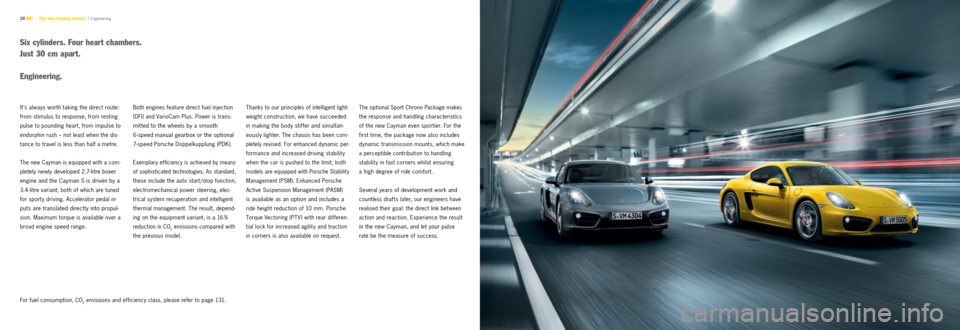
20
It ’s always worth taking the direct route:
from stimulus to response, from resting
pulse to pounding heart, from impulse to
endorphin rush – not least when the dis-
tance to travel is less than half a metre.
The new Cayman is equipped with a com -
pletely newly developed 2.7- litre boxer
engine and the Cayman S is driven by a
3.4-litre variant, both of which are tuned
for sport y driving. Accelerator pedal in -
puts are translated directly into propul -
sion. Maximum torque is available over a
broad engine speed range. Both engines feature direct fuel injection
(DFI) and VarioCam Plus. Power is trans
-
mit ted to the wheels by a smooth
6-speed manual gearbox or the optional
7-speed Porsche Doppelkupplung (PDK).
Exemplary efficiency is achieved by means
of sophisticated technologies. As stand ard,
these include the auto start/stop function,
electromechanical power steering, elec -
trical system recuperation and intelligent
thermal management. The result, depend -
ing on the equipment variant, is a 16 %
reduction in CO2 emissions compared with
the previous model.
Six cylinders. Four heart chambers.
Just 30 cm apart.
e ngineering.
Thanks to our principles of intelligent light -
weight construction, we have succeeded
in making the body stiffer and simultan-
eously lighter. The chassis has been com -
pletely revised. For enhanced dynamic per -
formance and increased driving stability
when the car is pushed to the limit, both
models are equipped with Porsche Stability
Management (PSM). Enhanced Porsche
Active Suspension Management (PASM)
is available as an option and includes a
ride height reduction of 10 mm. Porsche
Torque Vectoring (PT V) with rear differen -
tial lock for increased agilit y and traction
in corners is also available on request.
For fuel consumption, CO
2 emissions and efficiency class, please refer to page 131.
The optional Sport Chrono Package makes
the response and handling characteristics
of the new Cayman even sportier. For the
first time, the package now also includes
dynamic transmission mounts, which make
a perceptible contribution to handling
stabi l ity in fast corners whilst ensuring
a high degree of ride comfort.
Several years of development work and
countless draf ts later, our engineers have
realised their goal: the direct link bet ween
action and reaction. Experience the result
in the new Cayman, and let your pulse
rate be the measure of success.
The new Cayman models |
Engineering
Page 12 of 69
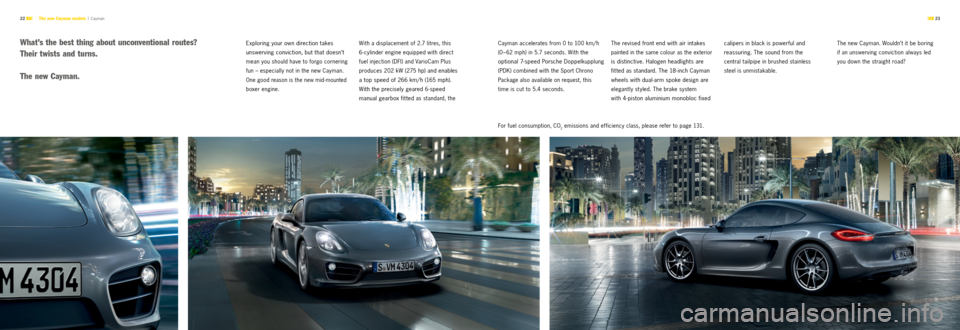
23
22
Exploring your own direction takes
unswerving conviction, but that doesn’t
mean you should have to forgo cornering
fun – especially not in the new Cayman.
One good reason is the new mid-mounted
boxer engine. With a displacement of 2.7 litres, this
6-cylinder engine equipped with direct
fuel injection (DFI) and VarioCam Plus
produc
es 202 kW (275 hp) and enables
a top speed of 266 km/ h (165 mph).
With the precisely geared 6-speed
manual gearbox fit ted
as standard, the Cayman accelerates from 0 to 100 km/ h
(0 – 62 mph) in 5.7 seconds. With
the
optional 7-speed Porsche Doppel
kupplung
(PDK) combined with the Sport
Chrono
Package also available on request,
this
time is cut to 5.4 seconds.
The revised front end with air intakes
painted in the same colour as the exterior
is distinctive. Halogen headlights are
fit ted as standard. The 18-inch Cayman
wheels with dual-arm spoke design are
elegantly st yled. The brake system
with
4-piston aluminium monobloc fixed calipers in black is powerful and
reassuring. The sound
from the
central tailpipe in brushed stainless
steel is unmistakable. The new Cayman. Wouldn’t it be boring
if an unswerving conviction always led
you down the straight road?
For fuel consumption, CO
2 emissions and efficiency class, please refer to page 131.
The new Cayman models |
Cayman
w hat’s the best thing about unconventional routes?
Their twists and turns.
The new Cayman.
Page 13 of 69
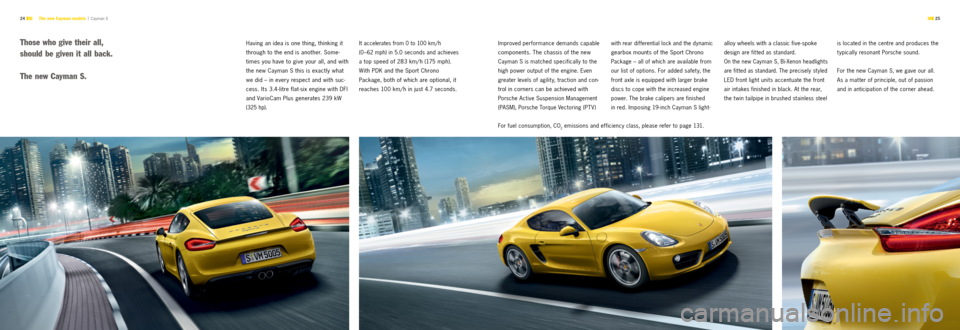
25
24 The new Cayman models |
Cayman S
Those who give their all,
should be given it all back.
The new Cayman S.Having an idea is one thing, thinking it
through to the end is another. Some-
times you have to give your all, and with
the new Cayman S this is exactly what
we did – in every respect and with suc -
cess. Its 3.4-litre flat-six engine with DFI
and VarioCam Plus generates 239 kW
(325 hp). It accelerates from 0 to 100 km/ h
(0–62 mph)
in 5.0 seconds and achieves
a top speed
of 283 km/ h (175 mph).
With PDK and the Sport Chrono
Package, both of which are optional, it
reaches 100 km/ h in just
4.7 s e c o n d s. Improved performance demands capable
components. The chassis of the new
Cayman S is matched specifically to the
high power output of the engine. Even
greater levels of agilit y, traction and con -
trol in corners can be achieved with
Porsche Active Suspension Management
(PASM), Porsche Torque Vectoring (PTV)
with rear differential lock and the dynamic
gearbox mounts of the Sport Chrono
Package – all of which are available from
our list of options. For added safet y, the
front axle is equipped with larger brake
discs to cope with the increased engine
power. The brake calipers are finished
in red. Imposing 19-inch Cayman S light-
alloy wheels with a classic five-spoke
design are fit ted as standard.
On the new Cayman S, Bi-Xenon headlights
are fit ted as standard. The precisely st yled
LED front light units accentuate the front
air intakes finished in black. At the rear,
the twin tailpipe in brushed stainless steel is located in the centre and produces the
typically resonant
Porsche sound.
For the new Cayman S, we gave our all.
As a mat ter of principle, out of passion
and in anticipation of the corner ahead.
For fuel consumption, CO
2 emissions and efficiency class, please refer to page 131.
Page 14 of 69
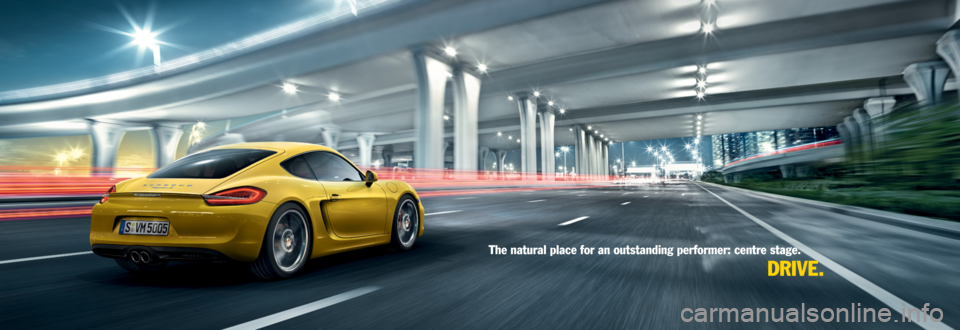
The natural place for an outstanding performer: centre stage.
DrIVe.
Page 15 of 69
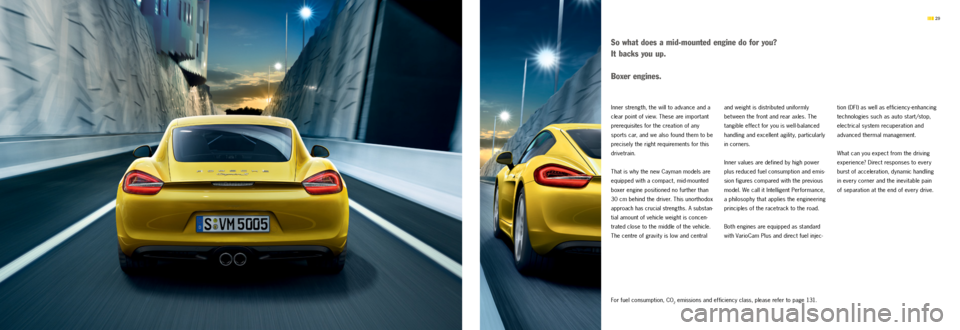
29
Inner strength, the will to advance and a
clear point of view. These are important
prerequisites for the creation of any
sports car, and we also found them to be
precisely the right requirements for this
drivetrain.
That is why the new Cayman models are
equipped with a compact, mid-mounted
boxer engine positioned no further than
30 cm behind the driver. This unorthodox
approach has crucial strengths. A substan-
tial amount of vehicle weight is concen-
trated close to the middle of the vehicle.
The centre of gravit y is low and central and weight is distributed uniformly
bet ween the front and rear axles. The
tangible effect for you is well-balanced
handling and excellent agility, particularly
in corners.
Inner values are defined by high power
plus reduced fuel consumption and emis -
sion figures compared with the previous
model. We call it Intelligent Performance,
a philosophy that applies the engineering
principles of the racetrack to the road.
Both engines are equipped as standard
with VarioCam Plus and direct fuel injec -
So what does a mid-mounted engine do for you?
It backs you up.
Boxer engines.
tion (DFI) as well as efficiency-enhancing
technologies such as auto start /stop,
electrical system recuperation and
ad
vanced thermal management.
What can you expect from the driving
experience? Direct responses to every
burst of acceleration, dynamic handling
in every corner and the inevitable pain
of separation at the end of every drive.
For fuel consumption, CO
2 emissions and efficiency class, please refer to page 131.
Page 16 of 69
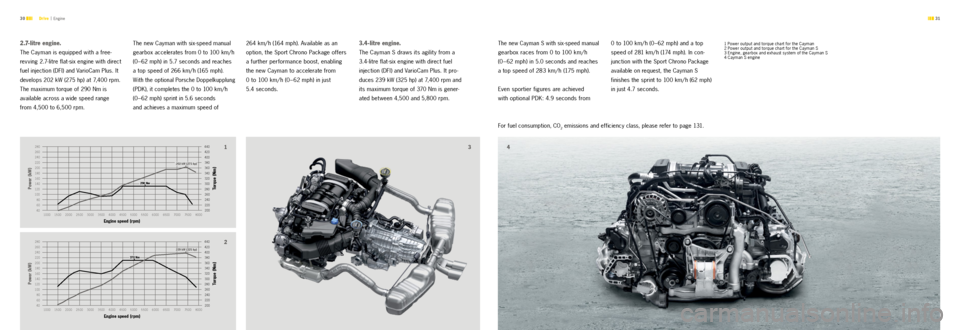
134
21 34
2
31
30
For fuel consumption, CO2 emissions and efficiency class, please refer to page 131.
2.7-litre engine.
The Cayman is equipped with a free-
rev ving 2.7-litre flat-six engine with direct
fuel injection (DFI) and VarioCam Plus. It
develops 202 kW (275 hp) at 7,400 rpm.
The maximum torque of 290 Nm is
available across a wide speed range
from 4,500 to 6,500 rpm. The new Cayman with six-speed manual
gearbox accelerates from 0 to 100 km/ h
(0 – 62 mph) in 5.7 seconds and reaches
a top speed of 266 km/ h (165 mph).
With the optional Porsche Doppelkupplung
(PDK), it completes the 0 to 100 km/ h
(0 – 62 mph) sprint in 5.6 seconds
and achieves a maximum speed of 264 km/ h (164 mph). Available as an
option, the Sport Chrono
Package of fers
a further performance boost, enabling
the new Cayman to accelerate from
0 to 100 km/ h (0 – 62 mph) in just
5.4 seconds.
3.4-litre engine.
The Cayman S draws its agilit y from a
3.4-litre flat-six engine with direct fuel
injection (DFI) and VarioCam Plus. It pro -
duces 239 kW (325 hp) at 7,400 rpm and
its maximum torque of 370 Nm is gener -
ated bet ween 4,500 and 5,800 rpm.
The new Cayman S with six-speed manual
gearbox races from 0 to 100 km/ h
(0 – 62 mph) in
5.0 seconds and reaches
a top speed of
283 km/ h (175 mph).
Even sportier figures are
achieved
with
optional PDK: 4.9 seconds from 0 to
100 km/ h (0 – 62 mph) and a top
speed of 281 km/ h (174 mph). In con -
junction with the Sport Chrono Package
available on request, the Cayman S
finishes the sprint to 100 km/ h (62 mph)
in just 4.7 seconds.1 Power output and torque chart for the Cayman
2 Power output and torque chart for the Cayman S
3 Engine, gearbox and exhaust system of the Cayman S
4 Cayman S engine
Drive |
Engine
4060 80
100 120 140 160 180 200 220 240 260
1500 75008000
2000 2500300035004000450050005500600065007000
1000
280
Power (kW)
T orque (Nm)
Engine speed (rpm)
200
280 300 320 340 360
380 400
420
220 240 260
440
202 kW (275 hp)
290 Nm
40
60 80
100 120 140 160 180 200 220 240 260
1500 75008000
2000 2500300035004000450050005500600065007000
1000
280
Power (kW)
T orque (Nm)
Engine speed (rpm)
200
280 300 320 340 360
380 400
420
220 240 260
440
239 kW (325 hp)
370 Nm
Page 17 of 69
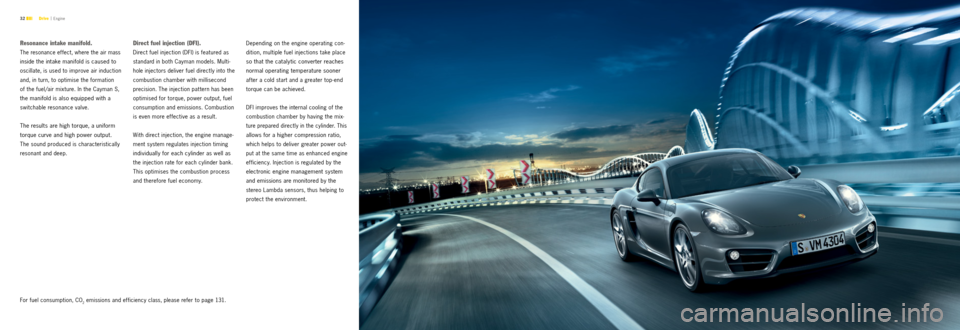
32
resonance intake manifold.
The resonance effect, where the air mass
inside the intake manifold is caused to
oscillate, is used to improve air induction
and, in turn, to optimise the formation
of the fuel/air mixture. In the Cayman S,
the manifold is also equipped with a
switchable resonance valve.
The results are high torque, a uniform
torque curve and high power output.
The sound produced is characteristically
resonant and deep.
Direct fuel injection (DFI).
Direct fuel injection (DFI) is featured as
standard in both Cayman models. Multi-
hole injectors deliver fuel directly into the
combustion chamber with millisecond
precision. The injection pattern has been
optimised for torque, power output, fuel
consumption and emissions. Combustion
is even more effective as a result.
With direct injection, the engine manage -
ment system regulates injection timing
individually for each cylinder as well as
the injection rate for each cylinder bank.
This optimises the combustion process
and therefore fuel economy. Depending on the engine operating con
-
dition, multiple fuel injections take place
so that the cataly tic converter reaches
normal operating temperature sooner
after a cold start and a greater top-end
torque can be achieved.
DFI improves the internal cooling of the
combustion chamber by having the mix -
ture prepared directly in the cylinder. This
allows for a higher compression ratio,
which helps to deliver greater power out -
put at the same time as enhanced engine
efficiency. Injection is regulated by the
electronic engine management system
and emissions are monitored by the
stereo Lambda sensors, thus helping to
protect the environment.
For fuel consumption, CO
2 emissions and efficiency class, please refer to page 131.
Drive |
Engine
Page 18 of 69
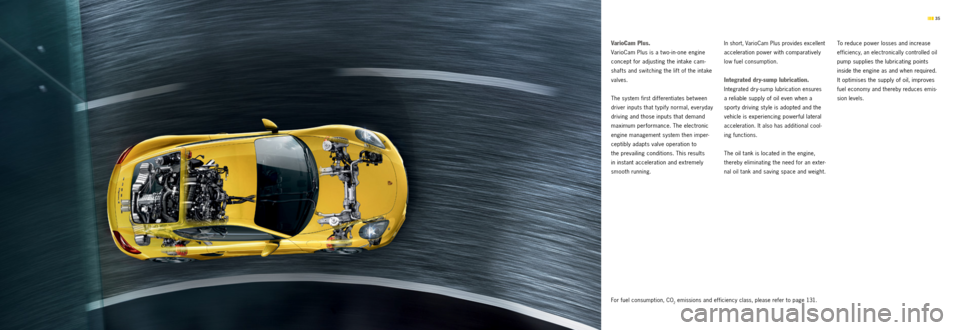
35
VarioCam Plus.
VarioCam Plus is a two-in-one engine
concept for adjusting the intake cam-
shafts and switching the lift of the intake
valves.
The system first dif ferentiates bet ween
driver inputs that typify normal, everyday
driving and those inputs that demand
maximum performance. The electronic
engine management system then imper -
ceptibly adapts valve operation to
the prevailing conditions. This results
in instant acceleration and extremely
smooth running.
In short, VarioCam Plus provides excellent
acceleration power with comparatively
low fuel consumption.
Integrated dry-sump lubrication.
Integrated dr y-sump lubrication ensures
a reliable supply of oil even when a
sport y driving st yle is adopted and the
vehicle is experiencing powerful lateral
acceleration. It also has additional cool -
ing functions.
The oil tank is located in the engine,
thereby eliminating the need for an exter -
nal oil tank and saving space and weight.
For fuel consumption, CO
2 emissions and efficiency class, please refer to page 131.
To reduce power losses and increase
ef ficiency, an electronically controlled oil
pump supplies the lubricating points
inside the engine as and when required.
It optimises the supply of oil, improves
fuel economy and thereby reduces emis -
sion levels.
Page 19 of 69

12
36
Thermal management.
The intelligent thermal management
system in the Cayman models regulates
the temperature in the engine and gear -
box
to reduce friction losses that occur
during the warm-up phase.
Thanks to the purposeful control of heat
flow and on-demand, gradual activation
of the various cooling circuits, the engine
and gearbox warm up to normal operat -
ing temperature more rapidly. The result -
ing reduction in friction also reduces fuel
consumption and CO
2 emissions. During
sporty driving, thermal management also
acts to reduce temperatures so as to
maintain a high degree of performance. Our cross-flow cooling system, as used
in motorsport, supplies each engine cylin -
der uniformly with coolant, which protects
all valves against thermal overload and,
therefore, premature wear. This improves
combustion and keeps emissions, fuel con -
sumption and noise comparatively low.
exhaust system.
In the new Cayman models, each cylinder
bank has its own stainless-steel exhaust
tract. Downstream of their respective rear
silencer, the tracts converge into a con -
necting tube and a single (Cayman) or t win
(Cayman S) tailpipe. The stereo Lambda
control circuitr y
controls and monitors each cylinder bank
separately. For each
exhaust tract, four
corresponding oxygen sensors regulate
the composition of the exhaust gas and
monitor the performance of the catalytic
converters. The separate
tracts enable
the exhaust gas to flow more
f re e l y. T h e
resulting reduction in pressure loss has
a positive impact on power output, torque
and the unmistakable engine sound.
Available as an option for the new Cayman
models is the sports exhaust system*
including sports tailpipe. It produces an
even more resonant Porsche sound.
1 Standard tailpipe of the Cayman S
2 Standard tailpipe of the Cayman
* Available from 03/2013 at the earliest.
Drive |
Engine
Page 20 of 69
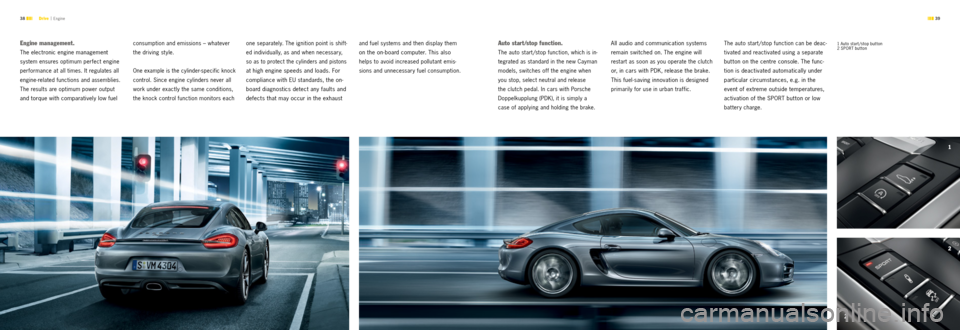
2
1
2
39
38
e ngine management.
The electronic engine management
system ensures optimum perfect engine
performance at all times. It regulates all
engine-related functions and assemblies.
The results are optimum power output
and torque with comparatively low fuel
consumption and emissions – whatever
the driving st yle.
One example is the cylinder-specific knock
control. Since engine cylinders never all
work under exactly the same conditions,
the knock control function monitors each one separately. The ignition point is shift
-
ed individually, as and when necessary,
so as to protect the cylinders and pistons
at high engine speeds and loads. For
compliance with EU standards, the on-
board diagnostics detect any faults and
defects that may occur in the exhaust
and fuel systems and then display them
on the on-board computer. This also
helps to avoid increased pollutant emis
-
sions and unnecessary fuel consumption.
a uto start/stop function.
The auto start/stop function, which is in -
tegrated as standard in the new Cayman
models, switches off the engine when
you stop, select neutral and release
the clutch pedal. In cars with Porsche
Doppelkupplung (PDK), it is simply a
case of applying and holding the brake.
All audio and communication systems
remain switched on. The engine will
restart as soon as you operate the clutch
or, in cars with PDK, release the brake.
This fuel-saving innovation is designed
primarily for use in urban traffic. The auto start /stop function can be deac
-
tivated and reactivated using a separate
but ton on the centre console. The func -
tion is deactivated automatically under
particular circumstances, e.g. in the
event of extreme outside temperatures,
activation of the SPORT but ton or low
bat tery charge.
Drive |
Engine
1 Auto start /stop but ton
2 SPORT but ton